This talk was first given at a Medicating Normal Meeting for mental health staff in Lexington Kentucky organized by Geoff Wilson and a few days later in May at the invitation of Don Marks to a group of clinical psychologists in Kean University New Jersey. I’m hoping it will lead to feedback from both groups and others.
It is twinned with Truth, Trust and Health also given at the same venues and both audiences were given a copy of Challenging my Doctor to Disclose.
Ghosts in the Machine is video version of this Fantasies talk produced by Bill James.
Slide 1: Years ago, just qualified in medicine, fortune pointed me toward 4 years of poorly paid lab research. .
Slide 2: Fortunately, serotonin system markers were the easiest thing to work on in the lab I went to. Early results hinted at something wrong with serotonin in depression.
By accident I found small tweaks to the methods – such as the time of day bloods were taken could lead to very different results. There are very few simple ‘facts’. There was and is a wide gap between facts and claims – through which company marketing departments march spouting all sorts of biobabble. Companies are better at making propaganda than drugs.
Slide 3: Fortunately also, two years later the first SSRI launched in Europe. Prozac was the fifth SSRI. Zelmid however ran into problems and had to be withdrawn.
Slide 4: When the SSRIs came onstream, my background made me a consultant to most of the major companies. It also came in useful when I hit on the idea of interviewing the key players presenting at psychopharm meetings. How did things look back then? How did the discoveries happen? The people who had been there talked unguardedly to a sympathetic interviewer. I interviewed 100 folk, picking guys on opposite sides of disputes and sitting their interviews side by side.
These can all be downloaded for free from the Samizdathealth.org site, specifically from Shipwreck:
The interviewees included Nobel Prize winners like Arvid Carlsson – who came up with the idea for SSRIs but got his Prize for dopamine which you’ll hear about later. The interviews made it clear how big a role new techniques rather than brilliance played in this field. The most impressive interviewees were people like Carlsson who had a knack for listening to people, seeing simple things and being honest – sure SSRIs can cause suicide.
Slide 5: This won’t look simple to you. It’s the chemical structures of the first tricyclic antidepressants. They look the same but some psychiatrists were saying – nope there are big differences. The two on the top are the same. The bottom left one, desipramine, is very different to the top left one and even more different to the bottom right one. clomipramine.
Believing peoples observations of drug effects, Carlsson said all 4 of these inhibit norepinephrine reuptake but the bottom right one inhibits serotonin reuptake most and the bottom left one least – let’s eliminate norepinephrine and see what a selective serotonin reuptake inhibitor does?
Carlsson had no ideas about fixing a broken serotonin system. He figured the doctors and patients were describing the effects of a drug on a normal system that might be put to good use.
Slide 6: Carlsson helped put the idea of chemical neurotransmission on the map. Before him neuroscientists like Walter Hess who also won a Nobel Prize, did not ask questions like are serotonin or dopamine levels high or low but what is the function of this biological system. Challenging his pupils, he asks Do you think studying monolayers of cells will tell you why you fall in love with a girl?
For all these guys – and they were all guys – love was clearly the most important function.
Slide 7: When the SSRIs launched in the early 90s, it was clear to insiders they were Serenics – Anxiolytics to you. These are not good antidepressants. A crisis with benzodiazepine dependence meant they had to be marketed as antidepressants. Cases of Valium needed to become cases of Prozac. Easy the marketers said. See The Marketing of 5-HT.
Slide 8: The message in this paper from Pfizer’s Zoloft launch in the UK in 1992, which I chaired, was Serotonin is more primitive than Estrogen or Testosterone. Drugs acting on it will show us things we have never seen before. We need to keep our eyes open. See 5-HT and Physical Illness.
Pfizer’s message was we know all about Zoloft – doctors just need to prescribe it and patients to swallow it.
Slide 9: The goal of marketing is to own the market – If you own the market the product sells itself. Marketing saw to it that cases of Valium became cases of Prozac and Zoloft. And made sure SSRIs corrected a Vitamin Serotonin abnormality – beautifully captured in this Leunig cartoon. No hint here of a serenic effect that might be put to good use if we understood it or of hazards we should keep an eye out for.
This marketing has a serious rarely recognized side effect. If the drugs correct a known serotonin defect they would not be expected to cause problems like suicide, homicide, dependence or sexual dysfunction. If they act on a normal serotonin system potentially unbalancing it, then a lot of things can go wrong.
Slide 10: Arvid Carlsoon was clear SSRIs could cause suicide and this has been obvious for over 30 years now. This features in other talk noted above – See Truth, Trust and Health. NIKS Aan de Hand is Dutch for Nothing out of Hand which means Everything is in Control – exactly the opposite to the picture…
Slide 11: This talk is built on two pillars. I help run RxISK.org an adverse event reporting site. Here you see, Anne-Marie, who 10 years ago made us aware SSRIs had made her and lots of others alcoholic. When she tried to tell AA and doctors she thought her SSRI had caused her alcohol problem, she was told this was typical alcoholic thinking – she was right and they were wrong. See Driven to Drink..
Her story is now embodied in Canadian Guidelines for Alcohol Use Disorders, which tell you to check recent onset alcohol problems for evidence of an SSRI induced component. Awareness is growing that psychotropic drugs may trigger other substance use disorders – see Did my Doctor make me a Substance Abuser.
Slide 12: The second pillar is built on these two guys, William James and Carl Lange, who in the 1880s said Emotions aren’t in our Minds. Our bodies get emotional and our brains trying to interpret this arousal often get things wrong.
Slide 13: Ideas like this sound primitive in our so sophisticated brain era. But tranquilizers from Milltown in the 1950s to Valium, the best-selling drug in the world in 1980, were built on fooling brains. Older treatments for nerves sedated – they knocked the brain out. Benzos didn’t. They relaxed muscular tension which fooled brains into thinking we are not anxious.
When we stop them, we often get rebound anxiety or rebound insomnia. They cause anxiety – how? What about by causing muscles to tense up again?
Slide 14: Using beta-blockers for anxiety also aims at fooling the brain by blocking rapid heart rates, sweating, or shakes – peripheral manifestations of anxiety. Beta-blockers are also used to treat cardiac and blood pressure problems and physicians, who know nothing about mental health, warn people when stopping them their brains might make a mistake and think their increased heart rates and possible shake mean they are anxious.
Many years ago in a pharmacology practical, I had to give a beta-blocker to a colleague and monitor her heart rate. This was supposed to demonstrate the well-known heart slowing effect. She became anxious. Her heart rate went up – supporting James Lange. It also showed me that reality is what is in front of us. Averages like beta-blockers slow heart rates are not reality.
Slide 15: Now I’m going to ask you for a little leeway here. T Rex is a Reptile. We often talk about Reptilian brains. These tiny brains can be amazingly efficient – they aren’t troubled by conscience or interpretations. The reptilian brain is not part of the cortex – which is most of the huge human brain you see here. The reptile bit is typified by the locus coeruleus. See the Blue Dot sitting at the top of the spinal cord, which mainly monitors our bodies – bladders and bowels – not the environment. If there is too much happening in the body this Blue Spot plays a big part in making us delirious.
This is what happens with opioid withdrawal. Opioids depress our heart and respiratory rates, and we can die. The Blue Spot compensates for this. Stop your opioid, the Blue Spot overshoots and our hearts and breathing go crazy, perspiration drips off us. Block Blue Spot overactivity with a drug like clonidine and opioid withdrawal is no problem. The craving, the appetite, for opioids is left behind – a problem we don’t have with Valium or Beta-Blockers or Antidepressants.
Slide 16: Perhaps James-Lange can explain Benzos and Beta-Blockers and maybe even opioids – what about antidepressants and antipsychotics?. I used to work in this unit in Wales. In 1999 we ran a healthy volunteer trial – blindly giving a bunch of staff either Zoloft or a norepinephrine reuptake inhibitor and later crossing them over to the other drug. Would staff repeat the observations that led Arvid Carlsson to create Zelmid?
No staff knew which drug they were on. It turned out that their observations did support Carlsson but in addition some perfectly normal volunteers became suicidal on the SSRI.
The most remarkable finding came from patients none of whom had any idea any staff were on anything. But within 24-48 hours, some of them could tell which staff were on the drug and could tell us which one. He’s reacting less – is he on an SSRI?
We are supposed to be the trained scientists who based on good observing adjust treatment, but we can’t spot things like this. Motivation is worth more than expertise.
Slide 17: What the patients saw should not be a huge surprise. People repeatedly tell us they can’t cry on SSRIs. They talk about emotional numbing.
This was well enough known to appear in a Charlie Brown cartoon decades ago. Lucy knows exactly what is going on. How come our left hands don’t know what our right hands know?
Slide 18: This Pet Scan shows exactly what Lucy knows and our patients could spot. The sensory areas of the Left Brain are lit up. The Right brain shuts down after volunteers have had one dose of an SSRI. The researchers say – Look just one dose can turn the brain off.
One dose of an SSRI has not turned this brain off. There is little serotonin in our brains – it’s in our guts, blood, peripheral nerves and even bones. These drugs act on sensory systems to shut them down and the lack of sensory input gives the picture you see here. We experience this lack of feeling literally as a lack of emotions. Our bodies are not reacting.
Now lawyers and juries dealing in criminal cases such as homicide, and us if we have family members on these drugs, think about responsibility for actions. Actions can stem from reflexes which you will hear more about later or from voluntary impulses. We are inclined to see most actions as voluntary and hold people responsible. Most behaviour however is reflex – automatic – and altered sensory input to those reflexes can disturb the reflex habits of a lifetime – leading to things like a change in personality.
Removing Beta-blockers and Benzos gave us an insight on the body these drugs are really acting on. Lets see what happens when we remove SSRI induced sensory blockade.
Slide 19: This 2005 graph shows a public health crisis. Within 3 years of its launch there were more reports of dependence on paroxetine to British regulators than there had been reports of dependence on all benzodiazepines combined in the previous 20 years. Once started, many people can’t stop SSRIs.
Slide 20: The word dependence conjures up images of brains needing these drugs – so why a skin image for a brain problem? SSRIs are antihistamines – the drugs you take if you have itchy skin or allergies. People attempting to withdraw have a lot of skin issues – some of which are very sensory, with others more allergic or inflammatory sounding. See Side Effexor Withdrawal.
Slide 21: Stopping SSRIs brought new phenomena into view like this which is called Electric Head or Brain Zaps. It’s a shocking problem known about for 3 decades. This image looks more like a brain effect. No one knows what causes it – except it’s not a brain problem. It appears to be a scalp muscle, peripheral nerve and eye problem – moving your eyes triggers it.
Slide 22: What is also shocking is that if we were doing science or medicine, you’d expect scientists and doctors to race in and start researching it. They haven’t. Websites tell us no one wants to talk about Electric Head for fear of alarming patients about dependence. What’s up?
Slide 23: 150 years ago, 3 different German doctors described 3 patients who developed severe anxiety after experiencing an I’m-going-to-die moment in a market-place. One doctor said it’s triggered by a problem processing visual information in this crowded place. The others said it’s a nervous problem. At that time a nervous problem meant something physically wrong with your nerves – it did not mean a psychological or anxiety based problem.
The patients all avoided market-places afterwards, giving the new condition its name – agoraphobia. Behaviour therapy aimed at blocking avoidance was later shown to help these patients.
A century later, Don Klein described panic attacks triggered by a severe I’m-going-to-die experience. He figured this was caused by a suffocation reflex. Klein’s suffocation idea hasn’t worked out and we now use CBT to manage the avoidant behavior panic attacks trigger.
Some of these conditions do come with real damage. We used to think Anxiety made people think they were having a heart attack. We know know that in takotsubo syndrome and SCAD there is real cardiac damage which couldn’t be seen until recently – See Just a Little Heart Attack.
Slide 24: Ten years ago, Persistent Postural Perceptual Dizziness PPPD was described. At its heart lies severe dizziness episodes. Imagine having a wobble on a tightrope. This can cause a severe and enduring shock leading to avoidant behaviors.
Slide 25: Balance is something we learn early in life. It’s got nothing to do with the cortex of our brains. The vestibules in our ear, our visual systems and our proprioceptive systems – a set of nerve endings in muscles, bones and joints that tell us where our bodies are – all coordinate to balance us.
Serotonin and dopamine are critical for the sensory receptors and nerves of our proprioceptive systems, vestibules, and eyes. Mess with them and things can fall apart.
Some people with PPPD have a vestibule problem and Vestibular Rehabilitation Therapy aimed at overcoming avoidant behavior can help. But instead, especially if you have normal vestibules you are likely to get another diagnosis and an SSRI.
Dizziness is a common early side effect of SSRIs, but it doesn’t trigger PPPD. Dizziness is among the commonest and most severe side effects on stopping SSRIs – even in healthy volunteers after 2 weeks on the drug. This is likely linked to Electric Zaps. It can cause PPPD. See Ondine’s Curse. But people with PPPD are told SSRIs are a Cure, even if their PPPD has come on after stopping an SSRI.
Slide 26: Look at the Eyeball in Niki McQueen’s extraordinary painting Juggling Act. SSRIs cause Visual Snow Syndrome involving visual snow, palinopsia, nyctalopia, floaters along with dizziness.
Slide 27: VSS is comparatively new. It’s linked to migraine but no-one with migraine gets away without a ton of drugs acting on their serotonin system. RxISK has reported the largest series of cases linking SSRIs to VSS. This can come on early in treatment, on stopping or after stopping treatment and can last indefinitely. Visual problems hugely increase rates of suicide. See Visual Snow Epidemic.
Ophthalmologists can’t see anything in the eye that might cause snow (upper left square), or the excessive floaters people complain of (upper right). They don’t ‘get’ why people with nothing wrong with their eyes end up so disabled – unable to work, unable to drive a car at night because of nyctalopia – middle right column, or socialize, and threatening suicide. The idea of a Functional Neurological disorder (FND) and treating the problem with SSRIs makes sense to them .
Slide 28: FND can be a legitimate but should be a rare diagnosis. Over-specialization seems to be leading to an epidemic of FND, which is getting diagnosed in drug-induced and vaccine-induced toxicity cases.
Drug toxicity cuts across classic syndromes and faces specialists with features outside their specialist area. Scared to blame the drug, and not wanting to offend colleagues who have prescribed SSRIs, the path of least resistance is to blame the patient. FND is a modern equivalent to hysteria – a kiss of death for anyone who wants to be taken seriously.
If symptoms like Dizziness and Visual Snow can trigger diagnoses of FND, it’s almost certain Anxiety or Depression will. After exposure to an SSRI for two weeks, healthy volunteers complain of Dizziness, Anxiety and Depression. Is an SSRI a treatment for this? Is this FND?
In patients these anxieties and depressions, symptoms of drug induced damage, get misinterpreted as manifestations of an original illness. These days almost no-one can see drug toxicity or withdrawal here. We can’t see our brains being fooled or company brains fooling us.
Slide 29: Within 30 minutes of a first pill, in 10% of an antidepressant dose, SSRIs numb genitals. This doesn’t just affect the person put on the pill it also affects their partner and the entire country. No-one is informed about this hazard. You may be laughed at if you report it.
In the image above, one of the two people you see is on or was on an SSRI. On stopping any sexual difficulties that were there beforehand can become much worse and can last for years after stopping treatment. You may be detained in a mental hospital and forcibly treated for crazy ideas if you report this.
Slide 30: We’ve known about Genital Numbing on serotonin reuptake inhibitors since 1970. While our right hands have known nothing about it, our left hands have used these drugs in very low doses given 30 minutes before love-making to treat premature ejaculation. And companies have been licensed to claim SSRIs are treatments for premature ejaculation.
In the mid-1980s healthy volunteers had serious sexual problems on SSRIs. Unaware of this, investigators like me were told not to ask about sex in clinical trials – leaving companies able to claim less than 5% of people had sexual issues and hint that any problem would clear the minute you stopped treatment. Companies already knew this was not true – that problems could endure for ever after stopping treatment.
A quarter of a century ago, a woman confronted me with PSSD – telling me she had been off treatment for more than 3 months and could take a hard-bristled brush and rub it up and down her genitals and feel nothing. There is no condition in medicine than can cause numbing like this – except a rare genetic defect of PIEZO2 proteins – and the numbing is continuous with what the drugs do after 30 minutes. This numbness leads to muted or absent orgasms and then loss of libido – a sequence that William James and Carl Lange would have predicted.
Folk on SSRIs talk about a loss of touch around the body and loss of erotic touch in their genitals. PIEZO proteins are mechano-sensory receptors, whose disruption in genital skin may add the extra loss of erotic touch element. The genital and emotional numbing people report correlate closely.
Slide 31: In terms of people on meds with no background in Healthcare telling experts what the meds really do, this podcast featuring Roy on the left, Bryn on the right and Simon below is scientifically worth more than close to the entire medical literature on these drugs.
Bryn: Getting PSSD undermines your faith in the medical establishment and the whole system of science as we have it – the fact that none of these professionals understand this condition or know anything about it when we know we have it – it’s not some vague feeling. Losing you libido is equivalent to going blind or deaf, it’s that level of sensory impairment
Roy: The same can be said for losing your emotions – I felt I lost two senses – my sexuality and my emotions
Bryn: If we want to be believed we have to remember just how incredible our story sounds … It’s a hard thing to wrap your head around… My Dad says it’s not possible a drug could cause these effects, it wouldn’t be on the market
Slide 32: But if you go on websites giving information on these drugs to the public you won’t find a mention of these the most common and most serious side effects of these drugs. Or that these drugs can wipe-out sperm counts, impair embryo implantation, and trigger miscarriages. Why not – because we don’t want to deter people from getting the benefits of treatment. Everyone from Joe Biden, to Emmanuel Macron in France, the Pope and others stick to this script.
Slide 33: An article appeared in BMJ 5 years ago that also featured on its front cover. The Brits and all developed countries are making love less often. The article blames depression – so the answer is give more antidepressants. SSRIs remember aren’t given for a serious depression, like melancholia, that might cause loss of libido – they don’t work for this. They are given for anxiety and most of us turn to things like sex and food if we are anxious.
The article doesn’t mention the SSRI public health problem – the 15% of people on antidepressants primarily because they can’t stop – remember this means maybe 20-30% of people aren’t making love the way they might want to. Why no mention? Because BMJ’s lawyers would not let a drug induced problem like this be mentioned.
Slide 34: An increasing number of countries are not just below but way below the reproductive replacement rate of 2.1 children per couple. Some sections of white affluent Britain are down to 0.6. The countries with the highest SSRI consumption are in general the one’s with the lowest fertility rates. Spain and Italy look like they will only have about three-quarters of their current population by 2050.
SSRIs haven’t caused this problem on their own, but they will definitely block efforts to turn things around. In countries like Britain and the US, native rather than immigrant communities are more likely to be on the meds. The countries complaining most about immigration at the moment are increasingly dependent on their immigrants to do the work and keep social structures in place.
Slide 35: Before we turn to the implications for treatment or antidepressant withdrawal, William and Carl have one more big challenge. What about the antipsychotics – do they act on the body?
Slide 36: Arvid Carlsson won his Nobel Prize for work on dopamine, not serotonin. More than anything else, imagery like this, showing degenerating dopamine systems in Parkinson’s disease, made the idea of a serotonin defect in depressed brains seem plausible – even though less than 5% of our serotonin is in our brains.
Slide 37: Dopamine was discovered in the brain not the body. Googling dopamine system gives an image like this. No sign of the rest of the body here. The Dopamine Hypothesis of Schizophrenia was as widely trailed as the Chemical Imbalance Theory of Depression at one point.
Slide 38: The history of antipsychotics tells a different story. Chlorpromazine was first given to a person having surgery aimed at combatting the physical stress reaction cutting into the body triggers. Almost immediately, the surgeon noticed a behavioural effect he had never seen before. The lady he was going to operate on was curiously chilled out. Then, before chlorpromazine was given to psychotic patients, a man who tried it out reported driving his car through a red traffic light. His red means stop reflex was gone.
The original psychiatric view was that chlorpromazine helped delirium and mania – early reports said it was unlikely to help schizophrenia, When given to psychotic patients, it left them awake but all unnecessary movement, like reflexes to stop at traffic lights, seemed less likely to happen. Rather than rant and rave, they quietened down but would answer when spoken to. Movements were minimal.
The same can be seen in rats. These drugs inhibit conditioned avoidance. Is this a brain effect?
Slide 39: Long before we could do brain scans to find out where drugs go, we could get people to write things down. I don’t mean write interesting descriptions of how they felt – I mean we could check the size of their handwriting. The drugs make our handwriting smaller – stop the drugs and it reverts to normal size. This is an economy of effort effect.
Slide 40: As for Parkinson’s – its hallmark diagnostic feature is Lewy Bodies. It now looks like Lewy Bodies originate in the nervous system of the gut when proteins mis-fold. These then migrate up the Vagus nerve and get deposited in the brain.
Slide 41: This is called The Braak hypothesis. A recent study showed that if you had your appendix out or your Vagus nerve cut you were more likely to get Parkinson’s or Alzheimers – and also that people with some gut problems were more likely to get Parkinson’s years later while people with Parkinson’s and Alzheimer’s are more likely to have a prior history of gut problems.
Slide 42: Decades ago, after I put him on a low dose of Risperdal, a man reported that his wife told him he smelt different. Around the same time Joy noticed a change in smell in Les – 10 years before he showed any signs of Parkinson’s. We now know Joy and others can diagnosis Parkinson’s because of chemicals in a person’s skin odor. Some of these are now known and work is underway to pinpoint what triggers their production.
The change in skin-smell on chlorpromzine, a drug that began life as an antihistamine, is intriguing.
Slide 43: Antipsychotics are not antipsychotic. They act on muscles and skin to stop us attending to things. As the Loxapac advert showed, we may remain psychotic. Relatively low dose that make our handwriting smaller is likely all we need. Pushing the dose up may make things worse. This paper tells you the adverse effects of this patient’s drugs became evidence that he appealed to in support of his delusional beliefs.
Once we get to this point, we have a real bind because attempting to stop the drugs may give rise to problems that endure long after the drugs have been stopped. How do you explain to a person that the drugs he was on can cause enduring effects when no longer there – if that person has an alternate explanation that at this point looks more consistent with the facts on the ground?
Slide 44: The drugs don’t act on our brains – our brains have been programmed to think a certain way about these drugs.
Slide 45: Pharma program you and your doctor to see these drugs as Magic Bullets – they go where the problem is and exterminate the enemy. Swallowing this narrative hands control to pharma. The only role for doctors is to prescribe – and never not prescribe – and for patients to swallow.
Slide 46: A different narrative hands control back to us. Drugs embody therapeutic principles – something that can be put to good use if we get the right principle for the right person.
This slide shows you both laxatives and constipation come in 4 different kinds. The clinical skill lies in figuring out which one suits this constipated individual. Once a company gets licensed to call their drug a laxative, their interests lie in getting it prescribed to everyone with constipation. They don’t care if people are also on the other 3 types of laxative – but this is how we get treatment resistant constipation.
Most drugs are therapeutic principles rather than magic bullets – antihypertensives, hypoglycemics. With antidepressants we have serotoninergic serenics, norepinephrine reuptake inhibitors which enhance vigilance, mirtazapine like drugs which act like tonics and tricyclics which treat melancholia. The right drug for the right person can help. The wrong one can create treatment resistant depression. If the wrong one is an SSRI for instance, we give people a complex chemical imbalance for which there is no treatment.
These days an increasing string of people are applying for Medical Assistance in Dying rather than live with Treatment Resistant Depression that is another name for protracted withdrawal problems.
Slide 47: Some years ago a really likeable man tortured with OCD came to me. He was a heating engineer and was having awful problems accepting he had put wires back in the right place.
We tried SSRIs for this man. They didn’t help. We switched to clomipramine, added an antipsychotic. Nothing helped. He came back weeks later seeming better. He’d stopped the meds I’d put him on. I was pleased. Then he confessed he’d taken up smoking. I was pleased – I just wanted him better.
Before starting smoking, he’d researched, he said, and found studies showing nicotine can help OCD. He handed me a bunch of papers. The top paper had an author I knew. Arvid Carlsson, the man who listening to patients created SSRIs – and also found nicotine could help people who didn’t respond to SSRI.
Carlsson was the first person to mention therapeutic principles to me. For him Nicotine could be a therapeutic principle. That way to view drugs and listening to patients is key.
Slide 48: Here you see another take on that. Freud and Jung are on the left. Carl Rogers on top in the middle. Isaac Marks who created behavior therapy on the top right. On the bottom in the middle you have Aaron Beck of CBT fame and on the right Marsha Linehan with DBT. All completely different ways to treat people. All began as solutions to the problem their creator had. They seem like universal truths but aren’t. Each can work for some but not others. The wrong one may make you worse if only by making you think you’re a failure.
We are all wired differently and can respond in just the opposite way to things – withdrawing from an SSRI can cause PSSD or its opposite Persistent Genital Arousal Disorder (PGAD).
We need to stop making fundamental attributional errors – looking for the person to blame rather than the situation factors. Instead we need to focus on the brute reality that if we give a poison hoping to bring good from its use we may just poison you and poisoning almost by definition may differ from one of us to the next person. We need to drop the brain fantasies and focus on what is happening in front of us, not on what the books say.
Slide 48: Our brains are never in front of us. Our skin is yet we know no more about it than we knew a century ago. This famous image illustrating reflexes is when we began to credit our brain for everything. It comes from Descartes, who noting if our foot strays too near a flame, we instantly withdraw it. An image, supposedly, ran up nerve fibres to the pineal gland where the soul looking at it wisely decides to move the foot. The wisdom demonstrates the involvement of the soul – the word reflex for Descartes meant a wise decision based on reflection.
Slide 48: It took 200 years to put this right and recognize that reflex reactions happen without any brain involvement. The wisdom of the body takes care of things. Once the reflex arc was described it became possible to recognize that most of our behaviour is managed by our bodies and not our brains – with consciousness almost seeming like the steam-whistle on a locomotive, relatively inessential.
Slide 49: We now have a public health crisis for a few reasons.
- Because Joe Biden, Emmanual Macron, the Pope etc are too scared to hint our modern sacraments might harm us.
- Because things are complex. People respond in different and sometimes opposite ways to drugs – you may get PSSD or PGAD. We can’t predict what will happen you on meds.
- Trying to get off can be shocking and dangerous and lead to withdrawal phobia.
- People can often easily get off 3 of 4 physical dependence causing meds – antidepressants, anticonvulsants and antipsychotics – proving there is nothing wrong with their willpower, but they can’t get off the fourth. Your problem drug and mine will differ – we have no idea why..
- People blame themselves when this happens and doctors blame them.
- Descartes, opioid drugs and hyperbolic tapering have made dualists of us.
Slide 50: Hyperbolic tapering has appeared recently and been helpful in encouraging people to try and get off their meds. It can seem to work because lots of people do manage to stop, and going slow makes some sense, but if you aren’t able to stop the idea that science shows how to get off meds can cause people to blame themselves even more.
Current hyperbolic ideas are tied to brain scans of receptor occupancy as this slide shows – it mentions the Striatum of the Brain. We have no data and little idea what happens in other bodily areas where it looks like receptor linked PIEZO proteins or ACE-2 receptors can be damaged.
In the case of opioids, we know exactly which system gives rise to withdrawal – for SSRIs we don’t know. My problem might be sexual, yours may be visual and his may be PPPD. It’s not like opioid withdrawal and there is no reason to think any of it is brain based. Is there a common factor?
Slide 51: Every second, bodies take care of posture, bowels, bladders, breathing, heart rates, immunity, and combine these seamlessly. When behaviours become automatic, getting our brains involved is a recipe for disaster.
Our brains don’t decide to turn off for 8 hours every night, our circadian clock shuts things down. Ditto with being mentally sharp at certain times of the day and not others. Our brains aren’t in control of us – they are at the mercy of bodily functions.
Slide 52: Still at present almost everyone injured by antidepressants assumes they have a brain injury. The only evidence for this – hard to overcome evidence – is the injury was caused by a med called an antidepressant. Almost everyone with PSSD thinks this way – even though the genital numbing begins within minutes of a first pill.
Brain Fog is a common complaint on withdrawal – what could that be other than brains not working?
Any concert pianist playing Beethoven’s Hammerklavier Sonata will tell you brains don’t play this – it’s done by muscle memory. It’s probably the same with elite athletes put on meds. Disturbing proprioceptive systems interrupts muscle memory. Once that happens the brain has to focus harder on things it didn’t have to focus on before and gets frustrated at not being able to restore past performance. It feels like the problem is in your brain and not your fingers.
This is likely what happens when gymnasts like Simone Biles get the twisties in mid-Olympics, or golfers get the yips.
In terms of akathisia, everyone thinks it is a motor disorder. It isn’t. If it were a motor disorder it would be called a dyskinesia or dystonia. Its a sensory disorder – a sensation of irritability of restlessness. The best example comes from the genital akathisia found in PGAD, which like PSSD comes from stopping SSRIs. This sensation of genital irritability, gives rise to repeated unwanted orgasms and women asking for clitoridectomies to relieve the distress.
Intense sensations of unremitting and inexplicable irritable discomfort give rise to suicidal and homicidal ideation. To this day lawyers thinking brains have not explain this to juries. Juries being told about brains assume our suicidality or homicidality is in some way voluntary when it is not. This is an area we urgently need to look into.
Slide 53: We need to get back to thinking about bodies. Our bodies contain 95% of the serotonin in you and me and nearly as much of the dopamine.
The Covid vaccines left lots of people complaining of Brain Zaps – although we need to recognize they may also have had SSRIs which they got for bodily problems on vaccines called FND.
SSRIs, however, adjust ACE-2 receptors – the receptor the Covid Spike protein acts on. Lots of people with PSSD and withdrawal have antibodies to ACE-2 and anticholinergic receptors as do people who have had the vaccine. Do we know what is going on?
Peripheral neuropathy is a striking feature of psychotropic drug dependence – see the image of the burning feet here. It now looks like anticholinergic drugs – drugs that can help Parkinsonian problems – seem to be able to cure this by causing peripheral nerves to regrow or perhaps by untwisting PIEZO proteins which have gone into spasm.
Slide 54: This brings me back to Juggling and Niki McQueen’s fabulous image which sums up this talk. We spend years juggling our bodies to the point where we can do some miraculous things. Two year olds bop when music is put on. No one teaches them to do this.
Reptile and bird brains are capable of far more complex dancing or acting as in murmurating and migrating thousands of miles. Where does the cortex come in – perhaps in flexibly adapting in mid-ballet movement to an orchestral mistake. It gives us flexibility but not without a risk of making mistake.
A significant withdrawal problem on psychotropic drugs likely needs a lot of brute reconditioning of reflexes to regain control of complex bodily functions that have become imbalanced. Routine activity that creates predictable signals are likely important – for things like sleep. It will be like starting over again.
Slide 57: This vision leads to some interesting places. I’ve seen a friend have a close to death moment of the kind that led Klein to create panic disorder. His was caused by Nexium for reflux.
Ozempic is all over the news at the moment as a cure for addiction and everything – all through its action on the gut – nothing about the brain. It may help some but cause PSSD and other problems also.
The message is the one I gave Pfizer. Listen to your patients who are on it – they may be reporting things no-one else has ever seen before. They have more expertise than anyone else and no incentive to get things wrong.
Lots of drugs have an SoS profile – Symptoms on Stopping. Singulair – Montelukast, used for asthma and allergies, causes suicide, nightmares, panic attacks, and withdrawal. Merck says this can’t happen – because Singulair doesn’t get into the brain.
I’m calling Merck as my first witness in support of the case outlined here.
Slide 58: As life expectancy and reproductive replacement rates fall in most Western countries, with a growing polypharmacy pandemic, reducing medication burdens – deprescribing – has become the most important task in medicine.
This will force us to replace Evidence Based Medicine with a Relationship Based Medicine, as there are no RCTs that can tell us how to defuse the minefield many of us end up on. A doctor with some clinical experience and able to acknowledge mistakes, working with a person who more than anyone knows most about what of the meds they are on are likely to be the most difficult to stop – whose problems may differ from the next person on the same cocktail of meds..
FDA are convening a panel in June aimed at branding Benzodiazepines as inappropriately prescribed – to be stopped as quickly as possible. While lip-service will be paid to shared decision making, informed consent and lived experience, a host of folk will end up cold-turkeyed – inappropriately deprescribed – and killed as a result. See Potentially Inappropriate Deprescribing. Deprescribing and responsibility.
Slide 59: Those suffering badly from, or dying from, their effort to stop any of these drugs, which are far harder to stop than opioids, will be angry or their families will be. They will figure FDA or companies are to blame. They will talk about corruption. They will be wrong.
We are to blame – not those who were on the meds. Doctors and healthcare professionals. FDA are nothing if not pedantic bureaucrats, who will not do anything they haven’t been asked to do. This holds true for companies also – for other reasons. And we have not required them to establish how difficult it is likely to be to stop these drugs – not just psychotropic drugs.
We have asked them to test for abuse liability – is this drug an opioid – and they do. We have forced them warn about suicide risks in a way they didn’t do before.
FDA reflect the consensus among healthcare professionals. But over the last 3 decades healthcare professionals have been cancelled – see Truth, Trust and Health. We have not asked FDA to do a single thing in this area. It’s time for all of us, as the saying goes to ‘Ask our Doctor if…
Slide 60: This rework of the original Leunig cartoon gives a hint of the new conversations we should be having. We need to give our doctors the option not to prescribe – which is the best way to avoid later problems. We need to demonstrate that these drugs cause complex chemical imbalances.
Slide 61: The Leunig cartoon got doctored before this talk had come into view and it has a mistake in it – the word final word should be body.
Slide 62: when trapped on a rocky medical outcrop, we need to start paying more heed to our materiality and less to the fantasies that have landed us in this predicament.
Postscript
Here is a link to a recent article on Animal Consciousness which introduces the word Sentience – a word that perhaps can overcome some of our difficulties in this area.





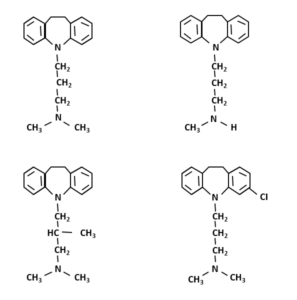

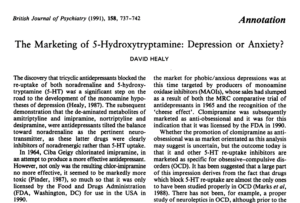
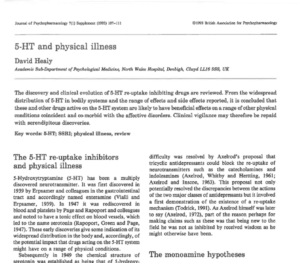
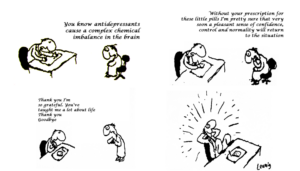




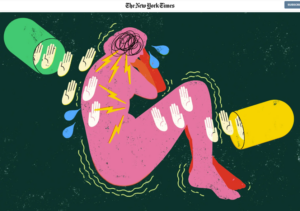
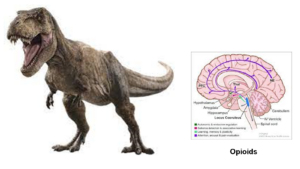

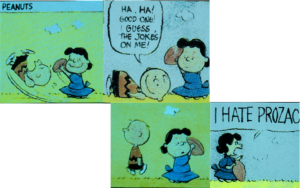
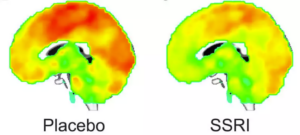
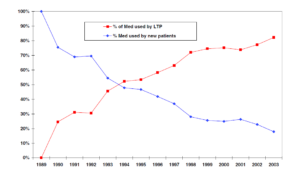

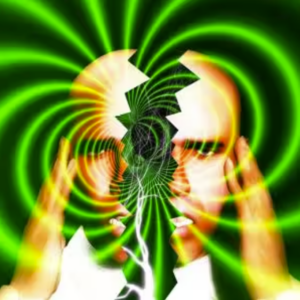

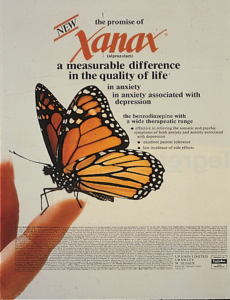

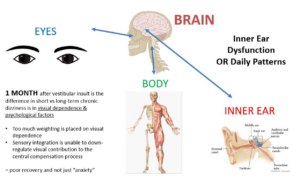
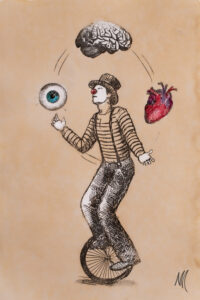

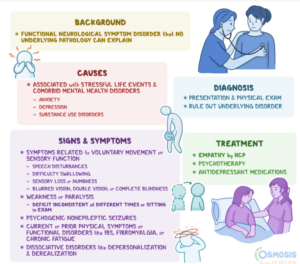

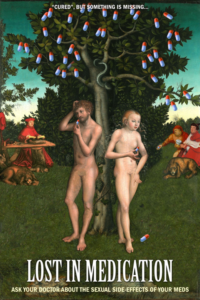
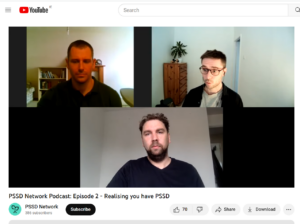
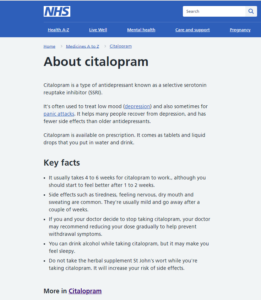


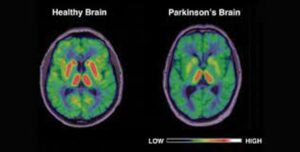
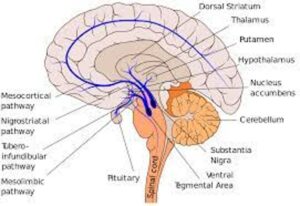
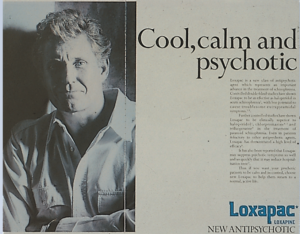

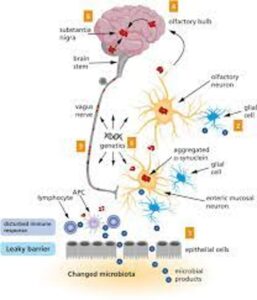
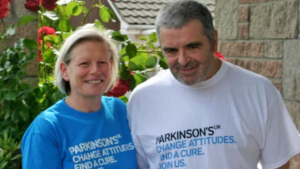
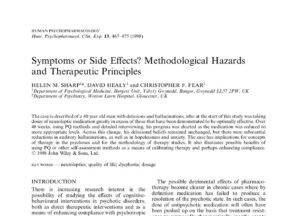
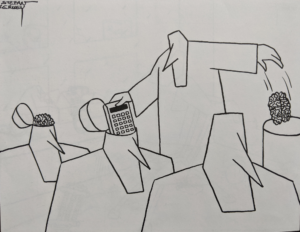
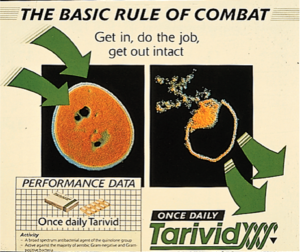
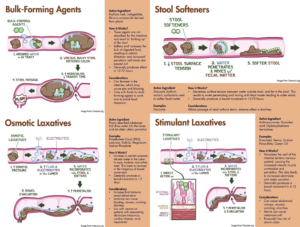

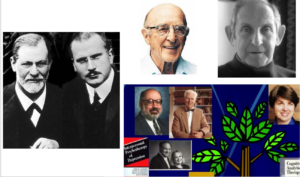
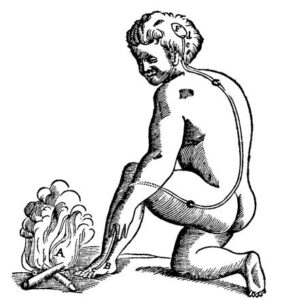
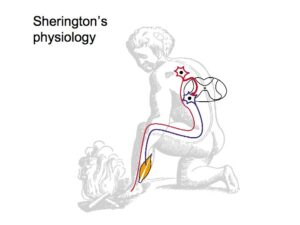
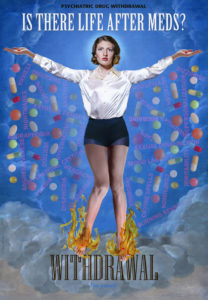
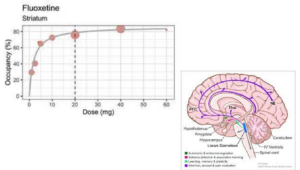
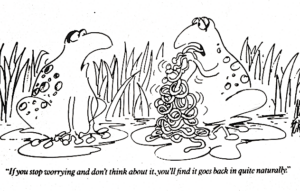

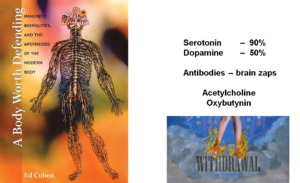
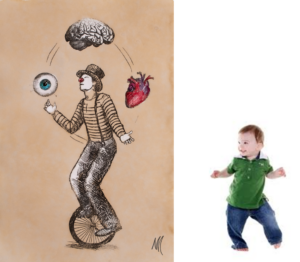



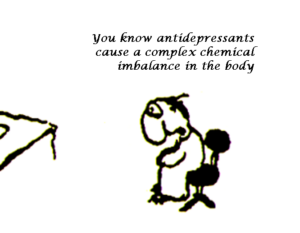

Peter Scott-Gordon says
Thank you for sharing this. It needs to be widely read.
Daniel says
great article! Can i ask for clarification? You wrote “Folk on SSRIs talk about a loss of touch around the body and loss of erotic touch in their genitals. PIEZO proteins are mechano-sensory receptors, whose disruption in genital skin may add the extra loss of erotic touch element. The genital and emotional numbing people report correlate closely.” I wonder does this close correlation also specifically occur between genital numbing and the non sexual forms of emotional numbing?
Dr. David Healy says
A close correlation between emotional numbing in general – nothing to do with sex – and genital numbing has been in the literature for over 20 years. Genital numbing appears to have 2 components – an erotic component and a touch component as in the usual sensation of touch around the body. The usual sensation of touch is numbed by SSRIs around the body and genitally and I find it hard to see that this is not the primary driver of the loss of ‘feeling’ we call emotional numbing. The links to a loss of erotic touch seem to be something else and not necessarily correlated a loss of touch sensation or emotional numbing if only because you can be emotionally numb without a loss of erotic feeling but you will be emotionally numb if you also have a loss of erotic feeling. This to me suggest that what happens in PSSD is something extra – like for instance a disturbance of PIEZO proteins.
Something may show up in gastric problems. Nausea is very common. But some people go on to problems like gastroparesis. There are close links between the serotonin and PIEZO systems in the gut – and genitals
D
Daniel says
wow i did not know that all of that was known, i must have missed it, now i kind of see more of where you are coming from when you write all these articles about the relation between touch/sensory experience and affect , i believed it was only a theory, i had never seen any such data ! can i ask if there also is data about correlation between pssd related cognitive problems and numbed usual touch or numbed erotic touch?
Dr. David Healy says
There likely is a link but its not been studied – adverse effects do not get studied because no one wants to deter you from taking your drugs.
D
Harriet Vogt says
Your comment set me off thinking…
‘This to me suggests that what happens in PSSD is something extra – like for instance a disturbance of PIEZO proteins. Something may show up in gastric problems. Nausea is very common. But some people go on to problems like gastroparesis. There are close links between the serotonin and PIEZO systems in the gut – and genitals.’
When we were researching semaglutide induced sexual dysfunction the other week – and its possible overlap with PSSD – this is how patients on reddit were talking:
‘all my desires and impulses seem low key’
‘I recently quit semaglutide after just 2 weeks because it destroyed my libido’
‘a general feeling of low energy and decreased sensitivity and decreased ability to achieve orgasm’
’ my libido decreased a lot, I don’t feel any interest in having sex’ ‘
I noticed the inability to climax soon after starting Ozempic. It is no doubt the drug. It’s a sad trade off for my health.’
No sign of the overall sensory and emotional deletion experienced by those with PSSD. But clear sexual dysfunction.
We know gastroparesis is a grim adverse effect of semaglutide. The court cases have already started https://lawsuitlegalnews.com/ozempic-lawsuit/ Look at the cadaverous state of usually gorgeous Sharon Osborne who cannot now put on weight :https://radaronline.com/p/sharon-osbourne-days-without-food-ozempic-42-pound-weight-loss/‘
Could this be something to do with the PIEZO system in the gut and genitals? Or am I joining the wrong dots?
A nurse on reddit had a commonsense explanation:
‘if you’re driving down your desire to eat, it is closely related to sex drive, and overall “lust for life”. This should be an expected outcome. I’m just a nurse, so… but I am surprised that this isn’t seen as an expected outcome.’
Maybe she’s right – semaglutide works by depressing satiety mechanisms – however that happens? You also mentioned a woman with PGAD being helped by Mounjaro, very like Ozempic – does it flip the satiety switch that then calms down her genital arousal? Could this at least be a way to help this suffering patient population?
I’m obviously confused with pre-school biochemistry – but feeling there’s a jigsaw puzzle or maybe bits of several in here.
Btw the Ozempic PIL contains no mention of sexual dysfinction, just predictable gastric complaints. https://www.medicines.org.uk/emc/files/pil.9748.pdf
chris says
“In terms of akathisia, everyone thinks it is a motor disorder. It isn’t. If it were a motor disorder it would be called a dyskinesia or dystonia. Its a sensory disorder – a sensation of irritability of restlessness. The best example comes from the genital akathisia found in PGAD, which like PSSD comes from stopping SSRIs. This sensation of genital irritability, gives rise to repeated unwanted orgasms and women asking for clitoridectomies to relieve the distress.
Intense sensations of unremitting and inexplicable irritable discomfort give rise to suicidal and homicidal ideation. To this day lawyers thinking brains have not explain this to juries. Juries being told about brains assume our suicidality or homicidality is in some way voluntary when it is not. This is an area we urgently need to look into.”
This is fascinating. The compulsion to kill oneself during akathisia, for myself, is something as well as ‘Intense sensations of unremitting and inexplicable irritable discomfort’ and is some how apart of being in what I would describe as very much slowed down or stopped time – like intense pain yet within a photo (stopped time) taken on the move to a moving subject, something Hilary Mantel articulated very well:
Every moment endures for an age and yet you are transfixed by the present moment, stabbed by it; there is no sense of time passing, therefore no prospect of deliverance. A desperate feeling of urgency – a need to act, but to do what, and how?”
“This is an area we urgently need to look into”
It is terrifying that it has been going on for so long and covered up with mental illness gaslighting and all around capture.
Dr. David Healy says
Chris
This is one of the most important points in the whole talk – thanks for picking it up and adding to it
David
brock says
Akathisia will kill me soon i have no choice left. While i absolutely don’t want to die because i have so much to live for, i want to live so badly. but I HAVE TO kill myself due to the distress this unbearable physical side effect that nobody in this world would be able to bear. It’s a physical torture.
I’m forced to take my own life 4 years after cessation of short term use SSRI. I’ve fought hard and long but it’s over i’m broken and i will be a statistic.
This is criminal at it’s worst. I hope my dear loving family can forgive me. It’s not my fault.
This is death by doctors prescription while i don’t want to die.
I love you mama
Brock says
Imagine
having a rope around your neck and being forced to kick the chair to escape the physical torture while you want to live and be with your family so badly.
That is akathisia
chris says
Eventually it is possible to come out of akathisia. There are people here who prove it. I’m one.
We know that benzodiazepine GABA drugs can effectively stop akathisia short term but can cause the problem if taken for any length of time. We also know that pyridoxal-5-phosphate the active form of B6 is a co-factor in the biosynthesis of GABA therefore it’s probably a good idea to try taking it especially if you are off all drugs. It would also be worth a try to eat foods low in glutamate and cut out caffeine totally. So far this has worked for myself while off all drugs.
Remember and keep telling yourself, eventually it is possible to come out of akathisia !
Anne-Marie says
Omg this is exactly it. You described that so well Chris. It’s such a hard thing to explain.
Every moment endures for an age and yet you are transfixed by the present moment, stabbed by it; there is no sense of time passing, therefore no prospect of deliverance. A desperate feeling of urgency – a need to act, but to do what, and how?”
chris says
Here is the full quote from the Booker Prize winning writer Hilary Mantel.
Harriet Vogt found it after I had read she had akathisia in the 70’s.
“The more I said that I had a physical illness, the more they said I had a mental illness. The more I questioned the nature, the reality of the mental illness, the more I was found to be in denial, deluded. I was confused; when I spoke of my confusion, my speech turned into a symptom. No one ventured a diagnosis: not out loud.”
“Do you know about akathisia? It is a condition caused by anti-psychotic medication, and the cunning thing about it is that it looks, and it feels, exactly like madness. The patient paces. She is unable to stay still. She wears a look of agitation and terror. She wrings her hands; she says she is in hell.
And from the inside, how does it feel? Akathisia is the worst thing I have ever experienced, the worst single, defined episode of my entire life. No physical pain has ever matched that morning’s uprush of killing fear, the hammering heart. You are impelled to move, to pace in a small room. You force yourself down into a chair, only to jump out of it. You choke; pressure rises inside your skull. Your hands pull at your clothing and tear at your arms. Your breathing becomes ragged. Your voice is like a bird’s cry and your hands flutter like wings. You want to hurl yourself against the windows and the walls. Every fibre of your being is possessed by panic. Every moment endures for an age and yet you are transfixed by the present moment, stabbed by it; there is no sense of time passing, therefore no prospect of deliverance. A desperate feeling of urgency – a need to act, but to do what, and how? – pulses through your whole body, like the pulses of an electric shock.
You run out into the corridor. A man is standing there, gazing dolefully towards you. It is your GP, the man at the student health service, the man with the rimless glasses and the polished brogues. The tension rises in your throat. Speech is dragged and jerked out of you, your ribs heaving. You think you are screaming but you are only whispering. You whisper that you are dying, you are damned, you are already being dipped into hell and you can feel the flames on your face.
And the answer to this? Another anti-psychotic. An injection of Largactil knocked me into insensibility. I lay with my face in the pillow as the drug took effect, and sank into feathery darkness; as I ceased to panic and fight, the hospital sheets dampened, and wrapped around me like ropes.
After I woke up I was maintained on Largactil. It was not a friendly drug; it made your throat jump, pulse and close, as if someone were hanging you.”
Anne-Marie says
The trust I had in Dr’s was quite niave of me when I ended up being so badly let down by them and having my life destroyed in the process of my treatment.
It has left me feeling we are living in a very corrupt country.
I really have come to the conclusion that they want to ruin our lives not to help us live a better one.
I have lost my faith in the medical system now and have learnt you really have to question everything.
Don’t trust anything anymore.
chris says
“I have lost my faith in the medical system now and have learnt you really have to question everything.
Don’t trust anything anymore.”
Yes I feel this most of the time but I did meet a physiotherapist the first part of this year who was brilliant in helping my mother for three months – that experience gave me some hope. I doubt she had any concept of all this though.
Harriet Vogt says
If you trawl the web for material on akathisia, it’s shocking how much Med Ed STILL promotes the nonsense ‘nosology’ of akathisia as a movement disorder, viz.
https://www.ncbi.nlm.nih.gov/books/NBK519543/
This is the main reason why Akathisia is misdiagnosed as madness, according to research quoted in this decent overview of the condition. Clinicians don’t seem to trust patients’ minds – nor their own:
‘Akathisia was originally considered to be a fundamentally subjective condition. However, there has been disagreement on the significance of the subjective patient experience versus the clinician’s objective observations’ (Hirose 2003).
The first description of akathisia that made me FEEL it, was from writer and artist, J A Carter-Winward. I read it years ago, maybe everyone else did too? But it bears repetition. Of course doctors denied her akathisia because her presentation excluded movement. And misogyny lurked in the form of a possible ‘BPD’ dx.
’I’m a writer by trade, so, I used my skills to convey the pain of the persisting akathisia to each doctor and neurologist this way:
Take every horrific feeling you’ve ever had in your life, all at once. Now, times them by 200, right in your gut. The “my-mother-just-died-and-so-did-my-cat-and-my-wife-left-me-for-my-best-friend” feeling. On top of those? A feeling of terror, panic, fear, as if you LIVE in a horror movie, and you must do something, or everyone you love will die, YOU will die — and you’ve no clue what that “something” is. So sick with this pain, caused by this neurological condition… so sick from it you can barely eat. That is how akathisia pain feels. It’s how it feels to me, and countless others who are experiencing it, or who have.’
I really like her redefinition of the tardive akathisia that she has survived for several decades as – a Traumatic Chemical Brain Injury. A conceptualisation that has given her a clear sense of treatment direction.
And, I particularly like her definition of the trauma:
‘The trauma of a chemical brain injury comes from the destruction of your trust in the medical system. Even if you have great, supportive doctors like I did — doctors who aren’t so busy covering their asses so you won’t sue them — who do whatever they can to help you, it was an easily-won faith from the time we were children, to trust our doctors. Trust the System.’
https://www.madinamerica.com/2018/11/drug-induced-akathisia/
annie says
Well, doesn’t this Settle a Few Scores – Enlightenment, with whistles attached
Slide 51: Every second, bodies take care of posture, bowels, bladders, breathing, heart rates, immunity, and combine these seamlessly. When behaviours become automatic, getting our brains involved is a recipe for disaster.
Our brains don’t decide to turn off for 8 hours every night, our circadian clock shuts things down. Ditto with being mentally sharp at certain times of the day and not others. Our brains aren’t in control of us – they are at the mercy of bodily functions.
Intense sensations of unremitting and inexplicable irritable discomfort give rise to suicidal and homicidal ideation. To this day lawyers thinking brains have not explain this to juries. Juries being told about brains assume our suicidality or homicidality is in some way voluntary when it is not. This is an area we urgently need to look into.
Supermarkets were mentioned.
This was one of my first ‘Off Paroxetine’ outbursts – in a supermarket. We were choosing bread, my eyes roaming the Ciabatta, French bread and suddenly I was in floods of tears and I ran out of the supermarket. What on earth is wrong, asked my partner, don’t you want bread? I was panicked, clammy and cold, a seeping terror swept over me. It lasted less then 20 minutes.
The inexplicable crying outbursts continued from time to time, then the massive amount of Head Zaps, the hyperventilating, the whooshing in the head, an entering of fear and fright, complete exhaustion. Trying to surmount all this, when trying to maintain my usual behaviour.
I was at a end of term summer play and sitting next to a parent “I really don’t feel very well” I remember saying. I am not the sort to vocalise things like that.
As 7 weeks off Paroxetine came, I woke in the early morning and literally ran into the surgery and beat the queue, to see the doctor. I said “you have to send me to a hospital, or I will……” That is when she admitted me to a mental hospital without listening to what I might have said.
If you are advised to come off a drug, and then all this stuff happens, it is not rocket science to put two and two together.
There has to be something else that is going on.
The unremitting accusations that the patient is at fault, seems to me, to be an unholy reasoning, from people, who have developed positions of power, because of their Medical Status, and so it has grown and grown, until they believe in themselves, so much, that all the worst traits of humanity, come to the fore.
You only have to look at the Pariante ‘Guff’ to see that.
Let alone the Wessely, Gerada, Howard, Burn, type people, on their cruise…..
They exhibit the worst personality traits; the arrogance, the hubris, the unbridled sanctimonious reflections of themselves, who are just Puffs of Wind…..
Linda Santini, M.Ed. says
I didn’t know SSRIs work by lowering one’s histamines—that’s so interesting! Biochemists have known for about 80 years that you can get a blood test to measure your histamine level so I had our family doc order one for my “incurable” “bipolar with psychosis” relative. The results showed his histamine level was almost double the upper limit of normal (40-70 ng/ml) which Carl Pfeiffer, MD wrote about in his books. So I lowered my loved one’s histamine level with Sam-e from the health food store. At the same time, I slowly (over 4 months) tapered him off of THREE, different daily antipsychotic drugs until he was just on the Sam-e and other supplements recommended by Dr. Pfeiffer. Then I hired a professional homeopath who CURED him, safely, deeply, gently and permanently. – Linda, author of “Goodbye, Quacks – Hello, Homeopathy!” Beware conventional psychiatry—it’s quackery.
Dr. David Healy says
I didn’t say SSRIs work by lowering histamine. We don’t know that they do. They are derived from antihistamines which means they have some effects on histamine but may commonly increase it. Their anti-serotonin reuptake inhibition is spun as increasing serotonin.
The problems they cause are likely mostly through actions on the serotonin system that are vastly more potent than they should be. A much less potent action would have been a better bet for patients
D
Harriet Vogt says
I know how significant this talk is because it was impossible to find just one or two perfect jewels to sum it up to quote on X.
The most fundamental intellectual disruptor – one of your two pillars – judging by reactions, is – we are not our brains. There are very few simple facts, as you say, but this is one of them. Clear to anyone who can quieten the mind and sense their bodies. But seemingly radical, subversive thinking to many clinicians and patients who have been brain washed by the pharma and psychiatry narrative of the last 40+ years. I’ve punted James-Lange-Healy at some apparently clever docs and they’ve reacted as if I’m mad . Well. I suppose they do that – reflexively.
The implications for understanding the effects and harms of drugs – as you articulate them so compellingly – are fundamental.
A couple of things that perplexed me – a bit…
Why did Don Klein’s suffocation reflex theory bite the dust? The only time I panic is at 30,000 feet when turbulence hits (actually almost any change of engine note can do it). ‘THIS IS NOT HOW I WANT TO DIE!!’ Instinctively I hyperventilate, feel faint and virtually stop breathing, etc. Is this not what Don Klein had in mind? CBT surely assumes that the person can exert conscious control over these instinctive reactions? I can’t . Or won’t.
Also I don’t really understand why you say, ‘Dizziness is a common early side effect of SSRIs, but it doesn’t trigger PPPD’. We know that 700+ drugs are ototoxic, we know that SSRIs can cause vision changes too. I don’t understand – biochemical thickie, probably – why PPPD can’t be an extreme and enduring reaction to these neurotoxic drug effects?. Ditto, sexual dysfunction (what a euphemism) whilst taking SSRIs – and PSSD – surely related?
Dr. David Healy says
Don Klein was likely right to say there are I’m going to Die Moments – that we should not ignore as triggers. And right that they are physical and do not stem from prior trauma or whatever. Like most people though he was looking for the one thing that could cause all such cases and plumped for a suffocation reflex that doesn’t hold up as the cause of all problems. Just like vestibular defects don’t hold up as the cause of all problems. Or Eye issues aren’t the sole cause. There is too much evidence linking hyperventilation to some of this to think that something respiratory isn’t a factor in some cases.
When we cannot pinpoint what point of origin of the trigger it is wrong to say its down to prior trauma and you need trauma based CBT. The body pays far more heed to fluttering heart rhythms and pelvic floor dysfunctions than it does to external threats. This was partly Klein’s point. He pointed to children with Ondine’s Curse who risk dying at any moment. Are they anxious? No. But give someone am out of the blue drug induced respiratory dyskinesia that can feel like you aren’t able to get any oxygen in and this can be extremely anxiety provoking. Nobody spots whats happening – because how could a drug we give you to calm you down cause such a catastrophic reaction.
Re SSRI – the general sense at the moment (it may be wrong) is that the dizziness that happens on starting an SSRI is not generally intense enough to cause PPPD – but the people who say this concede that the dizziness linked to withdrawal can be intense enough to cause it.
You’ve lost me with the last point about sexual dysfunction.
In general sexual numbing suggests the SSRIs are doing what we want them to do – numb, damp down. If this numbing continues after treatment stops – the apathy gets in the way of the capacity to be anxious. Angry yes, very anxious not usually.
The picture is quite different with PGAD where genital irritability giving rise to unwanted orgasms cause severe anxiety problems that can lead to drastic action. The numbing, anxiolytic effect isn’t there. Among the PSSD.PGAD community there are some people with elements of both This maps onto what happens in some suicide and homicide cases – the person is agitated to the point of drastic action and is numb to the consequences of acting on thought of how to get relief.
D
Mr Justin Oxley says
I read a few papers which showed that TRPC3 KO or inhibited mice exhibited difficulty in walking and clumsiness. Might a TRPC3 agonist be worth trying out as a potential remedy for PPPD ?
I have been drinking a strong Ginger brew I make in one of my French Presses to try and reduce the dizziness. I can’t say with certainty that doing this helps but it doesn’t do me any harm.
I stopped taking the 0.5mg liquid Fluoxetine each morning on Monday 26th May 2024 and behan taking 25mg Diphenhydramine on Monday 3rd June 2024. So far I have had a new electrical/vibrational feeling crop up which appears to travel up my neck without me tensing my neck muscles when I walk around.
I think the Anticholinergic action of the Diphenhydramine should help reduce my focal dystonia and dizziness. The magnitude of the vibrations I get in my neck muscles when I turn my head to the extreme left and right appears to have lessened and my neck is less painful as a result.
chris says
https://www.artnews.com/art-news/news/french-museum-report-on-vincent-honores-suicide-exploitation-1234709181
https://news.artnet.com/art-world/vincent-honore-death-ruling-workplace-accident-mo-co-2499291
I have been reading about this case of an art curator who died at work it’s been reported as both suicide and a work place accident and that he was in a stressed situation at work. Haven’t been able to find out if there is a coroner’s report. Like to know how he was found and if he went to his doctor with anxiety and possible insomnia due to work circumstance and if he was medicated. People who are under stress or possible abuse at work have a clear way out – they leave maybe gather evidence and go to a lawyer to see if the can sue.
But we have this reported :
” a note the curator allegedly sent to a friend around this time read: “I am trapped in the MO.CO., I will not be able to leave.”
He was a smart guy, think he would leave no matter what, also think he would have gone to his doctor if he was under pressure from a new boss.
If anyone finds any more information on this case pertinent to what we, on here, know about suicide I would like to hear about it.
Bob Fiddaman says
In the case of SSRIs, many were led to believe that they had a brain disease. This was down to pharma marketing and a psychiatry-driven narrative. Take this promotional push away and there is no incentive to prescribe these drugs. On the flip-side, many people become worse when taking them, or withdrawing from them, Auditory and vision problems, strange zaps that not only jolt the head but the whole body too. Genital numbness, suicidal and homicidal thoughts and potential harms to a fetus.
As you say, these aren’t researched because the outcome would probably deter people from taking them. Isn’t that the whole point of scientific research? As laypeople we would assume so but it’s pharma and their spin doctors who call the shots – those who go along with the narrative are, sometime down the line, called to task – often using the defence of, “I was going by what was known at the time” – A huge lie. What is known is gained by cross-examination, the truth is, hardly anyone ever questioned what they were being told, it all made perfect sense, for example, that melancholy and other similar feelings of feeling down were related to our brains.
The mind, you see, isn’t an organ – many shrinks I have debated with over the years have said the mind and brain are of the same – they failed to use mind and body because their emphasis was, and still is, on the brain. One can always run experiments on the brain to see it’s reaction, you cannot do the same with the mind, because it isn’t a thing and cannot be touched yet it can think, feel, perceive, imagine, remember, and will. Ironically, the mind is considered to be mental, which is probably where ‘mental illness’ came from. Imagine if, all those years ago it was labelled mind illness (as it probably should have been) – There would have been no lobotomies and, later, no drugs to fix a chemical imbalance of the mind.
Our minds have been monopolized – this has given power to control prices, limit competition, and dictate terms to consumers, “it’s not our drug, it’s a return of the illness.”
The overemphasis on the brain and the push to prescribe drugs like SSRIs have led to harmful consequences for many individuals. It is crucial to question the narratives pushed by pharmaceutical companies and psychiatrists, and to consider alternative perspectives on mind health and well-being.
If only pharma and psychiatry had in their possession a mind-scanner, eh. Truth is, they don’t and they never will – so, they’ll continue to push back on the brain thing – we’ll see more dodgy studies surfacing (See Pariante’s latest)
The ‘mind’ boggles.
Great slide show, have shared far and wide.
Fid
annie says
recovery&renewal reposted
Katinka Blackford Newman@antideprisks12m
Sharing an article I wrote on PSSD – front page of Mail online – grateful to the young people who bravely spoke out and to @joannamoncrieff and @RxISK
#pssd #antidepressants
Doctors reveal how antidepressants can PERMANENTLY destroy your sex life, cause pleasureless orgasms and numb genitals – as young people who have taken them say: ‘I’ve feel like I’ve been castrated’
https://www.dailymail.co.uk/health/article-13525863/Doctors-reveal-antidepressants-PERMANENTLY-destroy-sex-life-cause-pleasureless-orgasms-numb-genitals-young-people-taken-say-Ive-feel-like-Ive-castrated.html
The lawsuit and the EMA’s recommendations follow campaigning from RxISK, a patient support group that highlights the harmful side-effects of prescription medication.
Since first publicising this issue in 2011, RxISK founder David Healy, a former professor of psychiatry at Bangor University, has been deluged with calls, letters and emails from men and women suffering from PSSD.
‘We’ve been contacted by people in 37 different countries, both sexes and ages ranging from pre-puberty to people in their 80s,’ he says. ‘It’s an awful situation and we have no cure.’
The main symptoms of PSSD include genital numbness, inability to orgasm or pleasureless orgasms, erectile dysfunction, vaginal dryness and reduced sex drive.
Those affected also report emotional ‘blunting’ – meaning they can’t feel either positive or negative emotions.
chris says
Is the temperature dysregulation also a sensory issue and the body making an over response as a result?
Sorry if you have written about this already, I just do not have time to read and consider most of this important information in good time.
Dr. David Healy says
Absolutely – it’s one of the most important senses – vital to keeping us alive. It probably gets lost in touch which includes vibration, eroticism and lots of other things. There are far more than 5 senses. You can figure that most of what you call cognitive functions are in fact sensory functions. The Cognitive bits are where you get reprogrammed to agree that what looks black to you is really white. Ditto with cold etc
David
Bob Fiddaman says
Re temperature dysregulation
Interesting.
I slowly tapered off paroxetine (19months) I always found the ‘zaps’ more difficult to deal with during the summer months.
Patrick D Hahn says
Our health services industry has decades of experience in manufacturing “positive” outcomes for whatever intervention they are trying to sell us at the moment.
The same stupid tricks which were used to sell so-called “antidepressants” now are being used to sell sex reassignment surgery. What difference does it make if a pill lowers your score on a depression rating scale if you end up killing yourself anyway? What difference does it make if fantastically expensive sex reassignment surgery lowers your score on a gender dysphoria rating scale if you end up killing yourself anyway?
tim says
Thank you for these two brilliant linked blogs. The combined format of blog post and video lecture is particularly appreciated. After studying both posts on line for several hours, I was able to reinforce my understanding by listening to, and watching the video presentation.
I have begun to realise that in addition to proving unique and invaluable continuing medical education, these posts are therapeutic for those of us who have seen, shared and or experienced the life changing/life terminating outcomes of psychiatric misdiagnosis, mismanagement and iatrogenic injury.
annie says
Cool point by Chris.
I did look around for anything on the Art Curator odd ‘suicide’ but nothing to be found.
When I was in bed for weeks and weeks, two-years running, and because my ex-partner, was flying and landing on cockle beaches in the night with a nurse on board; mum was sitting in the garden in a very light top. I was under a 13.5 tog duvet, shivering, and popping all the pills the doctor had given me for relief from Seroxat, although, of course, she didn’t know it was Seroxat.
Two main legacies remain.
I still get Zaps, I still get the ‘jolts’ with any sudden noise. It sort of hurts, it sort of gives me a feeling of pain, it is way off what a sudden noise should bring. If a bird flies into my window, quite often in a caravan, I am off the rictus scale and feel like the poor bird lying concussed, who eventually, after a time lapse, gets his wings together.
To me Dan Johnson is the most amazing guy. He lost his 15 year old son to Fluoxetine, of that, there is no doubt. But despite this he has carried on examining his grasshoppers, teaching his students, giving us daily updates of his life with Dexter, when he must hurt so bad, that this young son, went in the spit of an eye.
Dan posted this yesterday
Dan Johnson
@DanJohnsonAB
·
22h
After two years, the official review of my complaint into the careless and needless death of the greatest guy ever, who made the world better even at just 15, has arrived.
I am sure Dan will share this when he is ready,; David taking the time to visit Lethbridge was an act of unequivocal kindness and respect, as David said it was ’emotional’.
It sure was emotional for us, too.
Dexter, and his dad, sure are the greatest guys ever…..
chris says
Thanks for looking re art curator Annie.
Last night and for the past two months I’ve been sleeping with a 1 tog duvet and when I wake up at about 2am sweating I put my silent fan on after drying myself off. The dizziness kicked in the other day going round a supermarket doing a 1 on 1 with my 90 year old mother. This is the way it is.
chris says
This sensory focus brings to mind William Sargent and Donald Ewen Cameron sensory deprivation abuse torture. I’m wondering were these issues seen in the trials?
We all know akathisia was clearly seen as “suicide attempt” directly from John Virapen’s account of Prozac trials, I doubt it was recognised as a sensory disorder. But the thought does cross my mind that it maybe a dastardly continuation of psychiatrys obsession with drug experimenting on humans without any informed consent.
Dr. David Healy says
Chris
Go back and read Zen and the art of Psychopharmacology on DH. It contains this section:
“As this quote about emotional numbing brings out, the effects of SSRIs are close to the opposite of the ‘mind-revealing’ effects of the psychedelic drugs which also work on sensory systems:
The mental symptoms are literally an altered state of consciousness that one absolutely cannot comprehend if he didn’t experience it. No words can explain such a thing. Every day I am shocked that such a state is even possible. It has nothing to with a mood disorder although it would make anyone depressed. The best way to describe it is mental anesthesia. Everything in the mind is tuned down so low, even thoughts. The mind is blank, emotions are so muted that they are barely relevant. In a way, it’s the opposite of what psychedelics do to the mind. They enhance and amplify what is going on whereas SSRIs completely mute it – so much that one has the impression that everything has been wiped out, and there is no mind anymore”.
The point being made here is that LSD notably acts on Serotonin receptors in sensory systems which are then read as mind opening – SSRIs seem to be doing almost exactly the opposite – they are mind closing.
D
susanne says
BREAKING: Medical Censorship Complex Targets BMJ Article for Retraction
Inbox
Aussie17 from PharmaFiles by Aussie17 Unsubscribe
Jun 14, 2024, 11:34 PM (9 hours ago)
BREAKING: Medical Censorship Complex Targets BMJ Article for Retraction
“The Princess Máxima Center explicitly distances itself from the controversial ‘anti-vax study’ by oncologists”
AUSSIE17
JUN 14
READ IN APP
So what happened? Let’s start from the beginning.
A recent study published in the prestigious BMJ Public Health suggested a stark and worrying connection between COVID mRNA vaccines and an increase in global mortality during the pandemic. This significant discovery is supported by numerous other research papers, indicating that mRNA gene therapy, though hailed as groundbreaking, may in fact have caused more harm than benefit, as many have suspected.
This study published in BMJ has skyrocketed in interest, becoming the most accessed publication in the history of BMJ Public Health. The first mainstream media outlet to cover this was The Telegraph, in an article entitled “COVID Vaccines may have helped fuel rise in excess deaths.” The article highlights that “experts call for more research into the side effects and possible links to mortality rates,” which is urgently needed.
The authors from Vrije Universiteit, Amsterdam, wrote: “Although COVID-19 vaccines were provided to protect civilians from morbidity and mortality caused by the COVID-19 virus, suspected adverse events have also been documented. Both medical professionals and citizens have reported serious injuries and deaths following vaccination to various official databases in the Western World.”
This acknowledgment of real and potentially severe side effects underscores the necessity for transparency and further investigation, rather than censorship and suppression.
Lo and behold, two weeks later, the medical censorship complex rallied against it with a disturbing ferocity, turning their considerable resources towards forcing the retraction of the article from the BMJ Public Health. This organized backlash is nothing short of a modern inquisition, aimed at suppressing any dissenting voices in the scientific community. Such outrageous actions betray the very principles of scientific inquiry and intellectual freedom.
Two days ago, a hit piece appeared in what is often described as a “left-liberal” newspaper. It was penned by the notoriously pro-vaccine journalist Maarten Keulemans, who predictably cited physicians and “scientists” known for their unwavering support of experimental gene therapy.
SOURCE:https://archive.is/2024.06.11-180900/https://www.volkskrant.nl/wetenschap/prinses-maxima-centrum-neemt-nadrukkelijk-afstand-van-omstreden-antivaxstudie-oncologen~bfa34cc0/#selection-1027.0-1031.268
English Translation
The Princess Máxima Center explicitly distances itself from the controversial ‘anti-vax study’ by oncologists.
The Princess Máxima Center for Pediatric Oncology is severely embarrassed by a study that was published last week. The study wrongly suggests that the excess mortality observed in various countries after the coronavirus crisis is due to vaccines.
At the heart of this storm is Saskia Mostert, the lead author of the BMJ article. Mostert has been recognized as a remarkably brave scientist — one of the few who dare to investigate the murky waters of medical corruption. Mostert has published many insightful commentaries fighting against corruption in health systems, such as the one titled “All It Takes for Corruption in Health Systems to Triumph, Is Good People Who Do Nothing”
SOURCE:https://www.ijhpm.com/article_3641.html
Yet now, her own home institution, the Princess Maxima Center, is shamefully attempting to isolate her and discredit her work. In what can only be described as a witch hunt, the center has announced an investigation into “how it was produced in more detail” and is looking for any pretext to retract the paper.
Here is the complete statement from Saskia Mostert’s home institute. (Highlights are mine)
The Princess Maxima Center Distances Itself from Publication on Excess Mortality during the COVID-19 Pandemic
June 11, 2024
The Princess Máxima Center distances itself from the publication “Excess mortality across countries in the Western World since the COVID-19 pandemic: ‘Our World in Data’ estimates from January 2020 to December 2022”.
Serious questions have arisen regarding the publication “Excess mortality across countries in the Western World since the COVID-19 pandemic: ‘Our World in Data’ estimates from January 2020 to December 2022”. Therefore, we will conduct further investigation into the scientific quality of this research. The Princess Máxima Center deeply regrets that this publication might give the impression that the importance of vaccinations is being questioned.
Originally, the idea was to examine the impact of COVID measures on, among other things, the mortality rate of children with cancer in low-income countries. During the study, the focus shifted in a direction that, in our opinion, lies too far outside our field of expertise: pediatric oncology. We are not experts in the field of epidemiology and do not wish to create such an impression. Therefore, the Máxima Center explicitly distances itself from this publication. We should have been more vigilant regarding the creation and results of this publication and will investigate how it was produced in more detail. If it is found that the publication was produced carelessly, it will be retracted.
As the Princess Máxima Center, we want to emphasize that we strongly support vaccination and that this publication should certainly not be read as an argument against vaccination. The study in no way indicates that there is a link between vaccinations and excess mortality; that is explicitly not the finding of the researchers. We therefore regret that this impression has arisen.
Potential Conflict of Interest?
When you scratch the surface, it’s no surprise to find that the Princess Máxima Center receives funding to conduct clinical trials. Specifically, two of the products they are funded for are Bosutinib and Inotuzumab, both cancer treatments developed by Pfizer.
Could this be the real reason why the Princess Máxima Center is distancing itself from Moskert’s study and now searching for reasons to retract it? Is it possible that Pfizer, the grand benefactor funding their research, isn’t pleased with Moskert’s findings?
Given this blatant conflict of interest, the Princess Maxima Center should immediately recuse itself from any investigation into Mostert’s study. Carrying on as the ‘impartial’ judge in this matter is farcical and deeply unethical.
This concerted effort to silence scientific discussion and bury inconvenient truths is profoundly disturbing. It illustrates the extent to which the pharmaceutical industry’s influence permeates both academic and media institutions. The eagerness to censor and vilify researchers like Mostert reveals an industry more interested in protecting its profits than fostering genuine scientific exploration or public health. The pharmaceutical giants have weaponized their funding and influence, turning trusted institutions into little more than mouthpieces for their narratives.
What we are witnessing is not just the suppression of a single study, but an assault on the very core of scientific integrity. Researchers are being bullied, silenced, and ostracized for daring to question the prevailing orthodoxy. This dangerous precedent undermines public trust in science and can have dire consequences for future medical advancements.
Just last month, I wrote an article that cited some doctors who are bullying others into silence. These doctors, who are making a living out of sucking the tits of the pharma industry, need to stop.
Of Silent Doctors and Bullying Doctors
AUSSIE17
·
MAY 10
Of Silent Doctors and Bullying Doctors
Recently, there were numerous new studies that raise concerns about the effects of mRNA. Feeling compelled by this, I took the initiative to reach out to several doctors. Some I know personally, and others I’ve been introduced to through referrals. They’re all quite informed and, for the most part,
Read full story
These institutions and doctors who are part of the medical censorship complex need to have a light shone on them and be shamed publicly. Please share this widely.
Dr. David Healy says
This is an important point which has been posted on Truth, Trust and Health on DH.org – any follow up comments should be posted there. The thread has more to do with Truth and Trust than Antidepressants
D
annie says
The Daily Mail, today; having another go at ‘Antidepressants’ – pity about the quoted, apart from Joanna Moncrieff…
Robert Howard, professor of old age psychiatry at University College London, says: ‘If my patients are having no issues with the drugs, I don’t see any reason they should come off them.’
Revealed: How scores of patients taking antidepressants suffer such severe withdrawal symptoms they are hooked on them for life
https://www.dailymail.co.uk/health/article-13533737/patients-antidepressants-suffer-severe-withdrawal-symptoms-hooked-life.html
They reported a terrifying catalogue of symptoms, including uncontrollable crying, panic attacks, intrusive thoughts, crippling insomnia and even attempted suicide.
Some even claimed they were ‘trapped’ on antidepressants – because the severity of withdrawal symptoms made coming off them impossible.
Shockingly, one reader who was prescribed antidepressants after being mugged and stabbed said that weaning himself off them had proved even more traumatic than the attack.
With more than eight million people in the UK on antidepressants, experts on both sides of the debate agree it is crucial to find out the truth: just how frequent are antidepressants’ withdrawal symptoms?
annie says
Two of the most vocal, Professors of old age psychiatry, Robert Howard and Wendy Burn, on Antidepressants.
Both have admitted to not seeing their elderly patients having any problems, either being on and coming off, and, staying on.
My mother had a fall at home. She was 89 and living independently. Three carer assistants, from a private company, came every day, to help out. It seemed to be working well.
I had been thinking of a private nursing home but no decisions had been made. I had found what looked like a wonderful place, a country-home residence. I had arranged that ‘Rose’, a senior nurse, would speak to my mother, at her home, to sound out her feelings about it.
My mother had a fall. Her near-neighbour, was called, with the contact device, mum used to wear around her neck. The neighbour called the doctor. At this point ‘Rose’ turned up for the appointment.
In her sitting room, with mum still on the floor, there was the neighbour, the GP and ‘Rose’. The GP called an ambulance. ‘Rose’ called me.
I immediately flew down from Scotland. Mum was delirious.
I went back to our house, and was shocked to find packets of an SSRI, on the kitchen table and tidying up, pills down the side of the sofa.
Back at the hospital, mum was in a state of what I can only describe as severe withdrawal. She was hallucinating badly, vocalising terrible things, it was very distressing.
I was with her daily for two weeks, and talking with Rose, we arranged that mum would go from the hospital to the nursing home, temporarily, whilst I headed home.
Shortly afterwards, it was mum’s 90th birthday. I was there, driving down with the dog, my first visit. They celebrated beautifully, mum looked gorgeous. She loved where she was. We agreed that this would be mum’s new home.
Five years later, after driving down often, and we having had wonderful days out around the Kent coast and country gardens, mum was bed-bound, on Fentanyl patches and morphine, for no cause that I could see at all, the hurried GP said, ‘we considered giving her an antidepressant but then we thought we wouldn’t know what was wrong with her’. Aaagh!
Holding my mum’s hand during her SSRI withdrawal for two weeks, in the hospital, and constantly bringing her mind back, gently, we did it between us and I dread to think what would have happened had I not been there. Nobody would have recognised it for what it was.
Dr. David Healy says
This interesting comment has come in from a reader. It almost suggests LSD like flashbacks raising a question as to whether others get something like this.
I just recently have been doing research on my past SSRI use. I can remember going through a weird psychotic episode when going cold turkey off Paxil. I was told it was non-addictive and there were minimal to no side effects. I was on it a little over a year. I did have lack of stamina, weight gain, foggy thinking, extreme tiredness and sexual side effects. According to my wife, even though I was calmer and had fewer panic attacks, I didn’t seem like myself.
When coming off it, I had weird things happen that I was not warned about. Within a day or two I got really sad but being angry and agitated at the same time. I can’t remember too much other than it seemed like a dream. I know I had vivid dreams, and this may have played into the dreamy state I was in. But the dreams were horrid and disturbing. They have been haunting me especially recently due to something triggering them. But I’ve never had episodes like that, before Paxil.
I read about Woody Witczak. and the episode where he held his head in a vise when first taking Zoloft and thinking his head was outside his body in a fetal position on the floor. I went through the exact same thing when I started. I was on the dining room floor looking at my wife after I woke up not knowing who I was or where I was. I felt like my head was on fire. It lasted for several minutes after waking up. I was asking, “What’s wrong with me.? “What’s wrong with me?
I was sad to hear about Woody and so many others who have lost or ruined their lives on these drugs. It’s appalling that the government and the medical and pharmaceutical industry as a whole promotes such dangerous drugs. Some may get short term relief for their initial symptoms, but the side effects were worse than the issue that it was treating.
I didn’t know withdrawing cold turkey would throw me into a similar mental tailspin. I had the physical withdrawal symptoms afterwards. But others have had similar experiences that I can relate to.
None of my doctors or Psychologists have validated my feelings about the medication. I always get an “interesting”, “alright”. “That was a long time ago, why are you worrying about it now?” Only those who have seen firsthand or did their research or most importantly, experienced these things can really understand. I’ve been trying to find video conferencing support groups to deal with my past trauma on these meds. I’m no longer on them so, I can vouch for “It was the Paxil”. That was almost twenty years ago, but it’s still causing ruminating and intrusive thoughts.
Dr. David Healy says
Has anyone else had anything like this?
DH
annie says
What a fabulous comment. Good to have.
A similar history, I was clutching at my head with the whooshing, the explosions and all the noise.
I had horrendous nightmares all the time. Even day time nightmares. Trying to sleep during the day, as sleep evaporated at night, I was scared to shut my eyes, as so much was going on in my head.
Terrible, shocking, nightmares, very frightening and traumatic. I couldn’t even tell you what they were about. I couldn’t even formulate to tell anyone – it was all part of the horror that seemed to change daily, bringing more and more and different changes – the whole thing was a very lengthy, ever-changing, network of head, body, sensations, interspersed with feelings of fright and terror.
.I don’t see how we can go through all this and not have some disabling features that show up long after the horse has bolted. I would guess that ‘flashbacks’ of some sort are more common than it is realised.
‘ Ruminating and intrusive thoughts’ are not to be taken lightly; being triggered by your dreams. “It was the Paxil”
Surviving ‘cold-turkey’ was a feat in itself; 20 years ago, it was a terrible mistake.
My head is still full of zaps, vibrations, white noise. It will pass at some point, until the next time.
Who knows what damage it did…
Anne-Marie says
I had very very vivid dreams on seroxat to the point I thought I had had real conversations with people. This came up once I was convinced a friend had told me something only for it to have been a dream I had had on seroxat. I was always getting muddled up with dreams and real life.
Mr Justin Oxley says
Ginger antagonizes activation of (M) 3 and 5-HT3 receptors.
https://www.ncbi.nlm.nih.gov/pmc/articles/PMC4818021/#:~:text=Collectively%2C%20these%20studies%20provide%20molecular,released%20from%20the%20gastrointestinal%20tract
Ginger also contains 5-HT1A partial agonist compounds.
https://www.sciencedirect.com/science/article/abs/pii/S0968089610002245?via%3Dihub
The first building I went to after I started working for Breathing Buildings Ltd in July 2011 was the the Houghton-le-Spring Primary Care Centre. The ventilation in this medical centre is provided by a thermal wall which had 49 penthouse ventilation louvres on the roof which sat above the dampers which could be adjusted to let cold air drop down the wall and into the waiting room and other areas when required. I was just learning the ropes at that point, my job as a PLC Controls Engineer was quite intense and we had to get quite a few ventilation systems signed off for a variety of schools/academy buildings around the UK. I had some problems being a bit spaced out whilst I worked for BB which I have attributed to my increasing tolerance to my daily dose of Citalopram. I also tended to drink quite alot of beers in The Cambridge Blue on Fridays at the end of the work week. I no longer have a craving for alcohol.
https://www.pandhs.co.uk/projects/houghton-primary-care-centre
Dr Shaun Fitzgerald is now the Director of the Royal Institution.
Johanna says
An early story on RxISK concerned gory nightmares triggered by withdrawal from Cymbalta:
https://rxisk.org/night-of-the-living-cymbalta-bs-story/
Almost 12 years later we continue to get comments on this story, the last just a month ago. The nightmares are startlingly similar in content, and very much out-of-character for the person involved (several readers mentioned they had not even watched commercial horror movies in their past).
Many also mentioned time- and reality-stretching aspects of these dreams: waking up convinced they were real, or feeling like the 45 minutes they lay awake afterwards had stretched into hours or days. For one woman, the dream-reality confusion took five days in the hospital to clear. Two years later, she’s free of the effect but feels her life has been shaken up in ways she still struggles to overcome.
We’re all raised with the vague idea of a subconscious mind that holds our “real” feelings, buried underneath the rules and values we were brought up with. What could be more horrible than to have these weird violent dreams, and believe they were parts of your real self breaking through? That alone might account for some suicides on SSRI’s. Simply knowing the source of these awful thoughts and images might literally be lifesaving in some cases.
Harriet Vogt says
Johanna asked this back in 2012:
‘I have always heard that dreams/REM sleep are essential for mental health, so perhaps any drug that suppresses dreams will mess with your mind either going on or coming off. Can anyone straighten me out here?’
Not sure if anyone did straighten Johanna out, probably did – but it’s intriguing, so I trawled the web for insights…
Since 2012, there has been quite a lot of research into what’s dubbed REM Sleep Behaviour Disorder (RBD), when healthy ‘sleep architecture’ is disturbed to the detriment of the sleeper and, in some cases, those with whom they might be sleeping.
Various causes have been identified – neurodegenerative diseases, alcohol withdrawal – and, with none of the usual obfuscation, SSRIs and SNRIs, not apparently TCAs, are fingered as a major cause. The organism is sort of under attack.
The theory goes that these drugs – and given the high incidence of nightmares in withdrawal, withdrawal from these drugs – suppress our healthy sleep architecture, especially the latency of REM sleep. Our normally restorative REM sleep periods are pushed back later into the sleep cycle – REM sleep normally starts about an hour in and is spread throughout the night, but with RBD we’re dreaming shortly before we wake – one reason why people suffering are more likely to recall their nightmares vividly.
REM sleep, as most will know, is the human system’s rather ingenious way of consolidating memories and, as I think of it, a sort of emotional filing system for significant personal events and feelings. If any of us reflect on the material that we have stored in our memories over a lifetime – childhood fears of cold, dead bony fingers grabbing our toes while we sleep (as a small child I used to get into bed by doing a sort of long jump to avoid whatever lay beneath) ,news footage of carnage, scary films like The Shining etc, – as well as our deepest fears – and ofc desires – add biochemical disruption and toxicity into the mix and it’s not surprising that antidepressants can turn our dreamscapes into horror movies.
One phenomenon I’d never heard of is that, apparently, during healthy REM sleep our bodies go into a sort of automatic paralysis. But if we have RBD, this mechanism fails and we can flail about and potentially become quite violent – to the point when some articles recommend putting away weapons. blocking windows and making sure partners are safe. This unnatural sleeping movement will obviously heighten the vividness of SSRI/SNRI induced REM Sleep Behaviour Disorder (RBD).
A few useful links:
https://www.everydayhealth.com/specialists/depression/expert-answers-on-treating-depression/
https://www.verywellmind.com/can-antidepressants-cause-strange-or-vivid-dreams-1067347
https://sleepeducation.org/sleep-disorders/rem-sleep-behavior-disorder/
Dr. David Healy says
H
The B in RBD means that we behave – act – while dreaming whereas normally we don’t. As you mention the paralysis or atonia that usually clicks into place when we dream doesn’t happen in people with RBD. We don’t know why this is. RBD may as H hints be a marker for other things going on. We don’t know if the RBD that SSRI triggers can lead to some of the bad outcomes that RBD often leads to. For anyone who does a little research having these vivid dreams can be a serious worry
D
Harriet Vogt says
D
You’re hearing the cogs whirring…
What is in my mind – is the overlap between SSRI induced RBD with horrific nightmares – and the waking, but almost trance like suicidal state some people experience from taking these drugs.
I was talking to a fantastic woman in the PSSD community the other day – they’re all so smart and brave and supportive of each other. She had taken mirtazapine for 3 weeks only – and it literally nearly killed her. She was wiped out, couldn’t function, couldn’t get her mind to work, couldn’t see properly. Will post more on that in ‘Detached retina…’
She vividly recalls being drawn inescapably to walking up and down, up and down, beside the railway tracks, unable to stop thinking about killing herself (so-called ‘intrusive thoughts’, I guess). But another part of her person knew that she didn’t want to die. And she didn’t. She’s recovered more or less from the debilitating mirtazapine ADEs after about a year – but still has to contend with grim PSSD.
Her experience feels a bit like lucid dreaming, which you’ll know about – but in case anyone doesn’t – it’s being consciously aware that you’re dreaming while you’re dreaming. And it feels a bit like it might be related to RBD.
I have no idea, in biological terms, how SSRIs could do any of this to a human being– but, in commonsense terms, it feels like their mind has been poisoned.
H/S
ahmet says
Dr Healy, I find your writings very informative and insightful but your solutions unconvincing and unrealistic. you claimed at the end of your talked that “the fda is not corrupt”. first of all there are innumerable instances where the fda is “corrupt” that is to say, they are acting contrary to their own laws and knowingly deceive the public. your books have many examples of this type of behavior. but more importantly, it doesn’t matter how the fda’s responsibilities are defined in legal terms in official documents. fda’s “mission” is to protect the public form private sector’s excesses; this is required in any market economy because a company should only care about its bottom line so some other institution, usually the government has to tasked with the public good. there can be no medical market as it is today without the government agencies active complicity. people know they can’t trust the companies but they still somehow belive the government institutions endowed with a ‘scientific’ authority. official agencies like the fda or cdc are the front for the marketing campaign of the medical industry. the state is both the shield and the spear for the capital. you don’t hear the company representatives proclaiming the safety and efficacy of their own products; you hear government officials doing that. in such a situation it would be very impractical to suggest the responsibility belongs to individual doctors. this is politically a dead end. it would still be more meaningful to ask the professional guilds like the ama or apa to change their behavior. in a market economy such as most of the so called ‘developed’ world, the government is responsible for the legitimacy of the entire system and it is also most amenable to responsive to political action because protecting public interest is the state’s primary role. it is completely right, legitimate and practical to attack the governmental agencies through all sorts of means; voting, pressure campaigns or more radical methods. of course only real comprehensive solution would be that medical corruption to be part of a wider project of societal transformation. this was called a hundred years ago; socialism or barbarism.
Dr. David Healy says
You’re missing the point. FDA is a bureaucracy – it is not a religious order or a crack military force. It sticks to rules. In the case of testing antidepressants or other pills there is no rule that says these have to be tested for symptoms on stopping.
There are no rules at present for testing the effects of vaccines given in pregnancy on a mother’s health – and it looks like they can cause serious problems to women and indirect problems for their babies.
If you or I figure there should be testing for symptoms on stopping or vaccine effects on the health of pregnant women, who is going to organize this? Nobody – not Biden or Trump or APA or AMA or whoever will do anything without a groundswell of opinion making it clear this is a real issue. Once a ‘leader’ realizes there is something here that needs doing (for whatever reason), then the rules can be changed and FDA will then do what they are told to do.
The problem with that is that the rules we put in place always look like they make sense in terms of managing corruption but when a strong source of corruption turns up he/they will just want one thing – these rules to work – as they pick up the thing we are trying to keep safe, put it on their back and march off with it. That’s a paraphrase of Chuang Tzu in 320 B.C.
D
ahmet says
Dr Healy, I think you are missing the forest for the trees. a bureaucracy is basically a government institution. there might not be specific laws which makes the fda responsible for some specific health risks and as you say there probably should be. the reason for that is probably to protect the state from inevitable future law suits. but that doesn’t really mean much because it doesn’t stop the fda shouting from the rooftops that the medicines are safe and effective. strictly legal responsibilities of these agencies are really beside the point because their main mission is protecting the public. fda, cdc and other official health agencies are at the front of all marketing campaigns regarding medicine. they shield the companies manufacturing the drugs and they attack the critics by all sorts of means using the awesome powers and legitimacy of the state. government agencies play the crucial role because no one is supposed to trust the companies; their only responsibility is to their shareholders as the rules of the market dictate. state’s role is curbing the excesses of the companies and protecting the public from their actions. this is why there is a state in a market economy. you can attack the companies only through law suits which could put them out of business but the system remains the same. you know, vaccine manufacturers were granted legal immunity by the government after law suits threatened their existence. this was also the case with the covid vaccines which were granted emergency use authorization without proper testing. who gave the companies these extreme privileges? fda is part of the state. when you attack an official health agency, you are really exposing the state’s role in facilitating and covering up the crimes of the private sector.
Dr. David Healy says
You are being idealistic and wrong. The bureaucratic ethic is to do exactly as they are told – nothing more or less. They do not lead.
D
Vee says
Bureaucrats, Goverments, Economy, Big Pharma, Consensus, Policies, Corporations, Institutions, and so on are PEOPLE. Some People get to decide how others will live. The ethos, zeitgeist, is focused on money. Vague, ambiguous, unknown, not known, may, might, cause, correlation, numerous definitions, numerous laws, numerous regulations, numerous interpretations ….. Risks, benefits, costs is not a safety guard for patients, clients, consumers; it is a weighing up of the economic gains against liabilities.
If prescribers wanted to leave the machine they would simply stop prescribing and go back to a do no harm model.
Pills are quick, easy, cheap options for the solution of impatience and low effort. Pop a daily statin for high cholesterol versus prepare healthier meals. What are the neuro-psychiatric adverse effects of statins!? Take anti-hypertensives versus lose weight. What are the neuro-psychiatric side effects of antihypertensives!?
[We] all seem to have plenty of time for the irrational taking of licit drugs and substances.
And by consensus [we] all seem to agree with the DSM, ICD, NICE, NIMH, FDA, et al. by going along with “evidence” and better yet, algorithms – we all get to be averaged.
If there is to be an end in sight to such propaganda, deceitful experimentation, then it will need to start with one less prescriber following orders, and one more genuine true friend standing with [us] in times of distress.
Iatrogenic harms, cascade prescribing for symptoms of known side effects of prescription and other substances and treatments needs its own research. But as DH points out, there will be no interest in such non-money-making ventures.